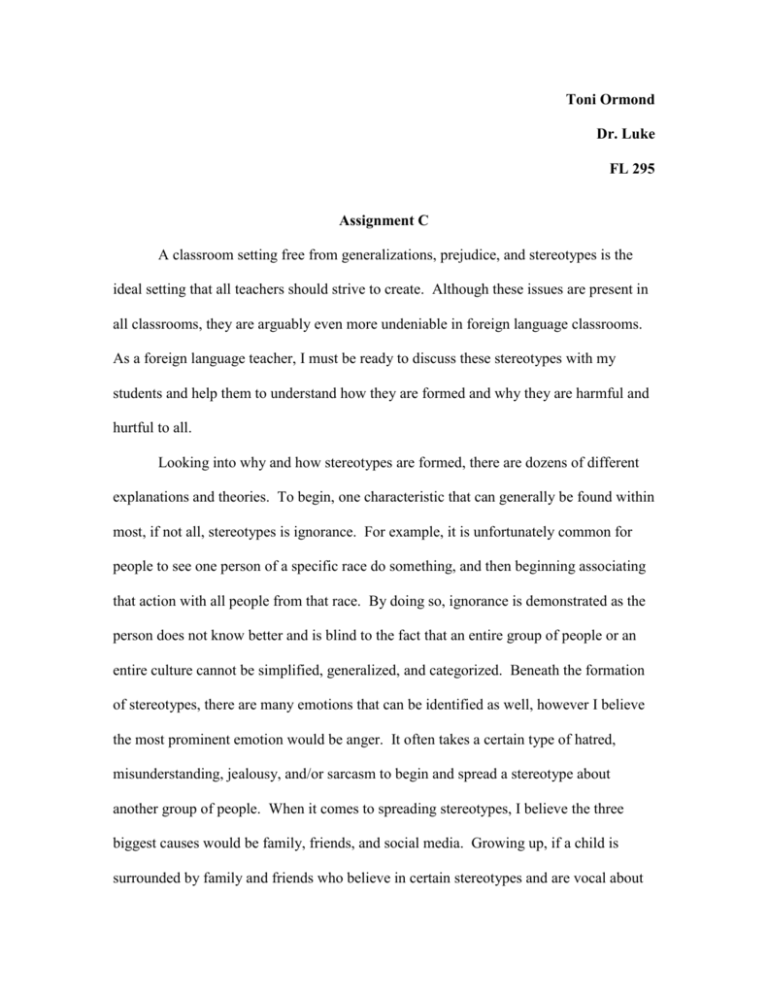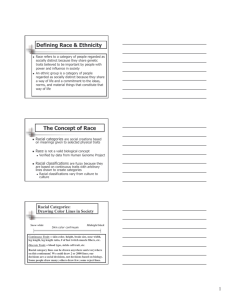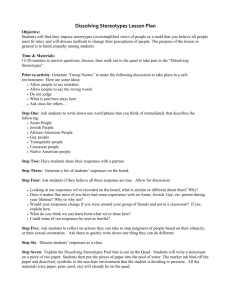INTASC 2 Artifact: Stereotypes in the Classroom
advertisement

Toni Ormond Dr. Luke FL 295 Assignment C A classroom setting free from generalizations, prejudice, and stereotypes is the ideal setting that all teachers should strive to create. Although these issues are present in all classrooms, they are arguably even more undeniable in foreign language classrooms. As a foreign language teacher, I must be ready to discuss these stereotypes with my students and help them to understand how they are formed and why they are harmful and hurtful to all. Looking into why and how stereotypes are formed, there are dozens of different explanations and theories. To begin, one characteristic that can generally be found within most, if not all, stereotypes is ignorance. For example, it is unfortunately common for people to see one person of a specific race do something, and then beginning associating that action with all people from that race. By doing so, ignorance is demonstrated as the person does not know better and is blind to the fact that an entire group of people or an entire culture cannot be simplified, generalized, and categorized. Beneath the formation of stereotypes, there are many emotions that can be identified as well, however I believe the most prominent emotion would be anger. It often takes a certain type of hatred, misunderstanding, jealousy, and/or sarcasm to begin and spread a stereotype about another group of people. When it comes to spreading stereotypes, I believe the three biggest causes would be family, friends, and social media. Growing up, if a child is surrounded by family and friends who believe in certain stereotypes and are vocal about their beliefs (possibly by sarcastic remarks or angry rants), then often these ideas can be passed onto the child. Additionally, in the 21st century social media has grown to be a powerful yet dangerous method to spreading opinions, pictures, videos, and really anything. For example, twitter is an online website that allows people to post, within 140 characters, anything they want. If something offensive is tweeted, it is only a matter of minutes before millions and millions of people can see it. As a foreign language teacher, I believe that early on in the semester I should have a discussion with my class about stereotypes. Before there are any issues, I should make it clear to my students that stereotyping in the classroom is unacceptable and will not be tolerated. In order to fully explain why stereotypes are harmful and to help my students understand this important lesson for life, I will use examples of stereotypes and explain how they were formed and how they spread over the years. Pertaining specifically to the target language, French, many make jokes about Canadians being too nice and friendly. Although many argue that this is not offensive to Canadians, it is crucial my students understand that it can become offensive when people start calling Canadians weak and defenseless. Additionally, my class needs to understand that you cannot generalize an entire country filled with people into a simple stereotype when all Canadians are obviously not necessarily nice and friendly. Another stereotype about Canadians that is not a fair depiction of the country as a whole is the idea that all Canadians play hockey. Again, although assuming every Canadian is a major hockey player or fan might not directly offend people, it could still lead to misunderstanding. It is never fair to assume anything about another person based on their culture, ethnicity, or religion, and instead I should teach my students to get to know each individual person for who they are because we are all unique. Teaching is not just about helping students learn a specific subject but it is also about teaching them lessons that they can apply outside of the classroom, for the rest of their lives. Helping my students understand the inaccuracy and improperness behind all stereotypes and teaching them how to avoid using them is a skill that will prove useful in all social settings they will ever find themselves in.


